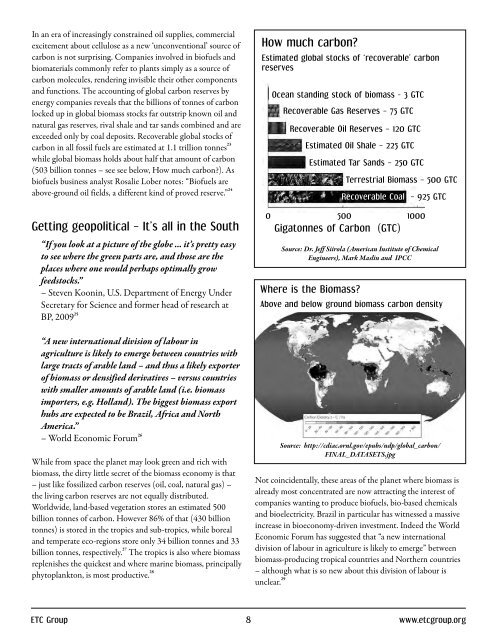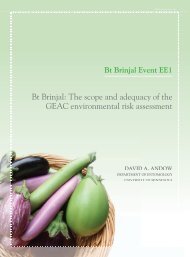English - pdf - 2145 Kb - Biosafety Information Centre
English - pdf - 2145 Kb - Biosafety Information Centre
English - pdf - 2145 Kb - Biosafety Information Centre
- No tags were found...
Create successful ePaper yourself
Turn your PDF publications into a flip-book with our unique Google optimized e-Paper software.
In an era of increasingly constrained oil supplies, commercialexcitement about cellulose as a new ‘unconventional’ source ofcarbon is not surprising. Companies involved in biofuels andbiomaterials commonly refer to plants simply as a source ofcarbon molecules, rendering invisible their other componentsand functions. The accounting of global carbon reserves byenergy companies reveals that the billions of tonnes of carbonlocked up in global biomass stocks far outstrip known oil andnatural gas reserves, rival shale and tar sands combined and areexceeded only by coal deposits. Recoverable global stocks ofcarbon in all fossil fuels are estimated at 1.1 trillion tonnes 23while global biomass holds about half that amount of carbon(503 billion tonnes – see see below, How much carbon?). Asbiofuels business analyst Rosalie Lober notes: “Biofuels areabove-ground oil fields, a different kind of proved reserve.” 24Getting geopolitical – It’s all in the South“If you look at a picture of the globe … it’s pretty easyto see where the green parts are, and those are theplaces where one would perhaps optimally growfeedstocks.”– Steven Koonin, U.S. Department of Energy UnderSecretary for Science and former head of research atBP, 2009 25“A new international division of labour inagriculture is likely to emerge between countries withlarge tracts of arable land – and thus a likely exporterof biomass or densified derivatives – versus countrieswith smaller amounts of arable land (i.e. biomassimporters, e.g. Holland). The biggest biomass exporthubs are expected to be Brazil, Africa and NorthAmerica.”– World Economic Forum 26While from space the planet may look green and rich withbiomass, the dirty little secret of the biomass economy is that– just like fossilized carbon reserves (oil, coal, natural gas) –the living carbon reserves are not equally distributed.Worldwide, land-based vegetation stores an estimated 500billion tonnes of carbon. However 86% of that (430 billiontonnes) is stored in the tropics and sub-tropics, while borealand temperate eco-regions store only 34 billion tonnes and 33billion tonnes, respectively. 27 The tropics is also where biomassreplenishes the quickest and where marine biomass, principallyphytoplankton, is most productive. 28How much carbon?Estimated global stocks of ‘recoverable’ carbonreservesOcean standing stock of biomass - 3 GTCRecoverable Gas Reserves – 75 GTCRecoverable Oil Reserves – 120 GTCEstimated Oil Shale – 225 GTCEstimated Tar Sands – 250 GTC0 500 1000Gigatonnes of Carbon (GTC)Source: Dr. Jeff Siirola (American Institute of ChemicalEngineers), Mark Maslin and IPCCWhere is the Biomass?Terrestrial Biomass – 500 GTCRecoverable Coal – 925 GTCAbove and below ground biomass carbon densitySource: http://cdiac.ornl.gov/epubs/ndp/global_carbon/FINAL_DATASETS.jpgNot coincidentally, these areas of the planet where biomass isalready most concentrated are now attracting the interest ofcompanies wanting to produce biofuels, bio-based chemicalsand bioelectricity. Brazil in particular has witnessed a massiveincrease in bioeconomy-driven investment. Indeed the WorldEconomic Forum has suggested that “a new internationaldivision of labour in agriculture is likely to emerge” betweenbiomass-producing tropical countries and Northern countries– although what is so new about this division of labour isunclear. 29ETC Group 8 www.etcgroup.org











